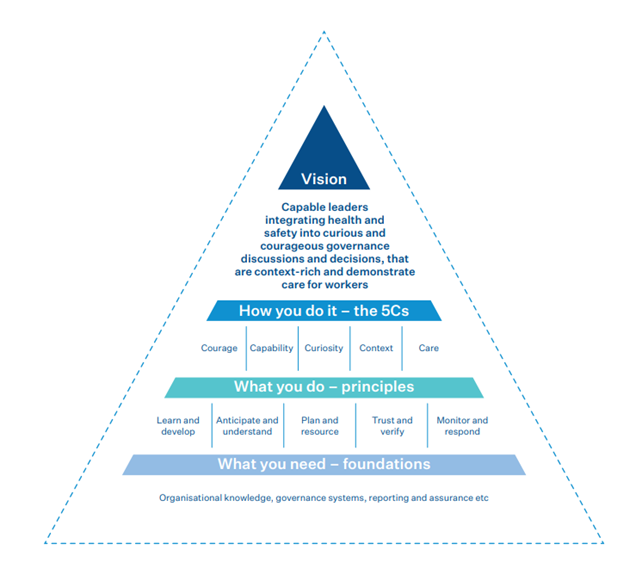The Institute of Directors (IoD) and WorkSafe New Zealand (WorkSafe) recently published an updated version of their 'Health and Safety Guide: Good Governance for Directors' (the Guide).
This article is the third in a four-part series which discusses recent developments relating to health and safety governance. The first article in the series is available here, and the second article is available here. We will be publishing a fourth article ahead of our webinar on Thursday, 5 September. The webinar will discuss health and safety developments in New Zealand and Australia relating to governance. Click here for further information and to register.
In this update we discuss the framework for health and safety governance contained in the Guide.
A framework for health and safety governance
The Guide states that a vision for good health and safety governance involves: “[c]apable leaders integrating health and safety into curious and courageous governance discussions and decisions, that are context-rich and demonstrate care for workers.”
To achieve this vision, the Guide sets out a framework which comprises three elements:

Source: Institute of Directors, Health and Safety Governance: A Good Practice Guide, page 19
- What you need: The purpose of this element is to establish the foundations for good governance. This element is focussed on processes and frameworks associated with health and safety governance and includes: the assurance programme for the organisation, the governance processes which are applied (eg what health and safety decisions are made by the full Board and what the Board’s role is in a non-routine situation) and what the health and safety expectations are for the organisation. Once the foundations are established, they need to be reviewed semi-regularly to ensure they remain fit for purpose.
- What you do: This element describes the activities which are undertaken to support the core principles of good health and safety governance. The principles include: learn and develop, plan and resource and trust and verify. The Guide also reiterates that from a legal standpoint, officers should always ensure they are carrying out actions which discharge their due diligence duty under the Health and Safety at Work Act 2015.
- How you do it: This element is focussed on a series of themes (described as the ‘5 Cs’) which are presented along with a series of questions to prompt self-reflection among health and safety leaders. The self-reflection is intended to support health and safety leaders to adopt a mindset which supports better health and safety performance. The ‘5 Cs’ are:
- capability – which acknowledges that the development of health and safety knowledge is a continuous endeavour.
- curiosity – which refers to the fact those in governance inquire and test how the organisation’s work is prioritised, planned, resourced, completed and experienced, and are constructively sceptical of continuous positive reporting.
- courage – which acknowledges that those involved in governance do not always have the answers and have the courage to admit the same.
- context - this relates to the continuous scanning and understanding of an organisation’s operating environment to understand how internal and external factors affect the work performed and the organisation more generally.
- care – which refers to an understanding that people are the most important asset in an organisation and that it is important that a culture is developed where those in the organisation can honestly and safely share to health and safety discussions throughout the organisation.
Ultimately, this framework intends to shift the practice of health and safety governance from a “compliance-focused and rules-based approach” to one which embraces the role that strong health and safety practice plays in the overarching performance of an organisation more generally.
The Guide contains a detailed discussion of each of these elements including the steps health and safety leaders can take to implement them.










